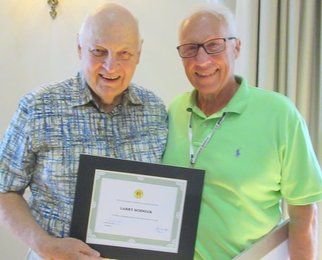SWEARING IN NEW OFFICERS FOR 2016
19th HOLE LUNCHEON
MEMBERS FOR 20+ YEARS
At our July, 26, 2016 meeting certificates were presented to those members who have belonged to the Old Guard for at least 20 years.
The following members were unable to attend this meeting and will receive their certificates at a later date. They are: Ralph Katz, Theodore Morse, Arthur Howard, Lawrence Ungar and Jay Schwab.
2016 DoD WARRIOR GAMES WEST POINT, NEW YORK
June 15th - JUNE 21st, 2016
June 15th - JUNE 21st, 2016
TAKE ME OUT TO THE BALL GAME
Ron Stytzer hit a homerun by organizing an Old Guard visit to Yankee Stadium for Yankees-Mets game. Fun was had by all. The Yankees won.
2016 ART SHOW
There were 30 entries in the Old Guard’s 2016 Art Show including oil paintings, water colors, photographs and needle point. The exhibit was held at the Westchester Hills Country Club.
Among the exhibitors were Max Ganem (whose painting of Mont Mart was judged “best in show”), Anupma Sethi, Lilyan Abramson, Ksenia Oksana Corales, Julie Cohan, Swan Brown Ronde, Steve Loewengart, Jerry Esteves, Ann Marie Dougherty, Stan Breiman and Joann Brown.
More than 50 members and partners of the Old Guard attended the biennial exhibit and lunch. One visitor commented that it was “absolutely amazing how talented the exhibitors are.” Another found the art work “quite extraordinary” and still another called one piece “stunningly beautiful.” All of them were absolutely correct.
The idea of a biennial Old Guard Art Show was conceived by Martin Kantor, assisted by Joann Brown, and this year’s show was dedicated to him. If you missed it, you missed a treat but, like the Olympics, it’s always possible to plan ahead for the next opportunity to see Old Guard talent on display. Mark your calendars now for August 16, 2018 and plan to be there.
Among the exhibitors were Max Ganem (whose painting of Mont Mart was judged “best in show”), Anupma Sethi, Lilyan Abramson, Ksenia Oksana Corales, Julie Cohan, Swan Brown Ronde, Steve Loewengart, Jerry Esteves, Ann Marie Dougherty, Stan Breiman and Joann Brown.
More than 50 members and partners of the Old Guard attended the biennial exhibit and lunch. One visitor commented that it was “absolutely amazing how talented the exhibitors are.” Another found the art work “quite extraordinary” and still another called one piece “stunningly beautiful.” All of them were absolutely correct.
The idea of a biennial Old Guard Art Show was conceived by Martin Kantor, assisted by Joann Brown, and this year’s show was dedicated to him. If you missed it, you missed a treat but, like the Olympics, it’s always possible to plan ahead for the next opportunity to see Old Guard talent on display. Mark your calendars now for August 16, 2018 and plan to be there.
AWARD CEREMONY FOR NEW MEMBERS EMERITUS
LUNCHEON FOR MEMBERS 90+ YEARS OLD
OLD GUARD OF WHITE PLAINS
DINNER DANCE 2016
SCARSDALE GOLF CLUB
DINNER DANCE 2016
SCARSDALE GOLF CLUB
Arthur Howard's 100th Birthday
OCTOBERFEST
at
TRAVELERS REST
at
TRAVELERS REST
WESTCHESTER CHORDSMEN









